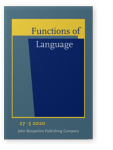Vol. 27:3 (2020) ► pp.340–372
More than just a modal particle
The enclitic =q’al in Sanzhi Dargwa
Modal particles have been intensively studied in German and a few other European languages, but investigations of modal particles from little-known languages are rare. This paper examines in detail the morphosyntactic and the semantic properties of the Sanzhi Dargwa (Nakh-Daghestanian) modal particle =q’al. It is shown that the particle possesses the morphosyntactic properties that are commonly assumed for modal particles. The particle is then analyzed as presupposition trigger that interacts with focus and marks clauses as declarative sentences. It triggers two presuppositions, namely uncontroversiality and contrast/correction. Furthermore, it can express finiteness. The analysis suggests that accounting for modal particles as grammatical rather than lexical items with head status seems promising for further research.
Article outline
- 1.Introduction
- 2.Setting the stage
- 3.The enclitic =q’al
- 3.1Meaning and function
- 3.2Morphosyntactic properties
- 4.Previous accounts of cognates of the Sanzhi particle in other Dargwa varieties
- 5.The many functions of =q’al
- 5.1Is =q’al a marker of shared knowledge?
- 5.2Is =q’al an adversative particle?
- 5.3The impact of =q’al on information structure
- 5.4Interim summary and open questions
- 6.Cross-linguistic parallels and implications for the study of modal particles
- 7.Summary and conclusion
- Notes
- Abbreviations
-
References
